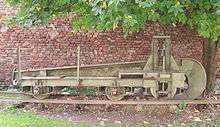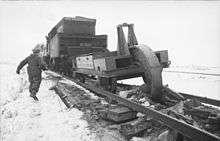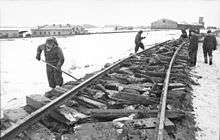Railroad plough

Railroad plough from Military museum in Belgrade. The hook can be raised up for transportation or lowered down for track destruction.

The plough in action

Track, destroyed by the railroad plough
A railroad plough (also known as a Schienenwolf ('rail wolf') or Schwellenpflug ('sleepers plough')) is a rail vehicle which supports an immensely strong, hook-shaped 'plough'. It is used for destruction of rail track in warfare, as part of a scorched earth policy, so that it becomes unusable for the enemy.
In use, the plough is lowered to rip up the middle of the track as it is hauled along by a locomotive. This action breaks the wooden ties which forces the steel rails out of alignment, making the line impassable by later rail vehicles; bridges and signalling equipment also suffer serious damage.
World War II
Railroad ploughs were in use by the Czechoslovakian army in 1938.[1]
Surviving vehicles
| Location | Image | Description |
|---|---|---|
| Belgrade Military Museum |  | A plough is on its permanent outer exhibition. |
| Historical Museum of Bosnia and Herzegovina | A plough is displayed in front of the museum. | |
| Victory Park on the Poklonnaya Hill | A replica of a German railroad plough is on display.[2] | |
| Unknown |  | A captured German World War II example was kept at the Longmoor Military Railway. This may have since been transferred to the care of the UK's National Army Museum. |
See also
- Sherman's neckties
- Nero Decree – Hitler's unfulfilled plan to destroy German infrastructure, during retreat, to avoid it being used by the Allied forces
References
- ↑ Pre-war fortification of Czechoslovakia in Czech Switzerland (entry for 24 September 1938) (Retrieved: 15 November 2007)
- ↑ "НЕМЕЦКИЙ ПУТЕРАЗРУШИТЕЛЬ «КРЮК» (ГЕРМАНИЯ).". 2012-07-26. Retrieved 2014-06-19.
External links
![]() Media related to Railroad ploughs at Wikimedia Commons
Media related to Railroad ploughs at Wikimedia Commons
- Photos of 'Rail wolf' in action and resultant damage
- Video of German soldiers using a rail plough.
- Andrew Grantham's blog
This article is issued from Wikipedia - version of the 11/30/2016. The text is available under the Creative Commons Attribution/Share Alike but additional terms may apply for the media files.